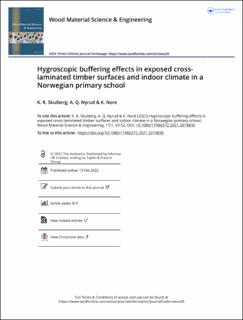Hygroscopic buffering effects in exposed cross-laminated timber surfaces and indoor climate in a Norwegian primary school
Peer reviewed, Journal article
Published version
Permanent lenke
https://hdl.handle.net/11250/3050920Utgivelsesdato
2022Metadata
Vis full innførselSamlinger
Originalversjon
Wood Material Science & Engineering. 2022, 17 (1), 43-52. 10.1080/17480272.2021.2019830Sammendrag
Laboratory studies have shown that wood has hygroscopic properties. When used as a construction material in buildings, it can thus influence indoor relative humidity and temperature. Ventilation can affect indoor climate if the temperature differ between indoor and outdoor air. The coating of indoor wood may also affect its hygroscopic properties. Few studies of wood in real buildings have been conducted. The main aim of this experimental study was to explore the association between moisture content in indoor air and wood in two classrooms. The floor plan of the two classrooms was identical. In one classroom, all wood surfaces were untreated, whereas, in the other, they were treated with a transparent varnish. Sensors measured indoor air relative humidity, moisture content in the wood, and temperature in the air and wood in both classrooms. Linear regression analysis was performed to explore possible associations. Strong positive associations between indoor air relative humidity and the moisture content in wood in the untreated classroom were found. Weak positive associations were evident in the classroom with treated wood. Ventilation reduced these associations.

